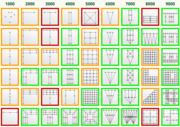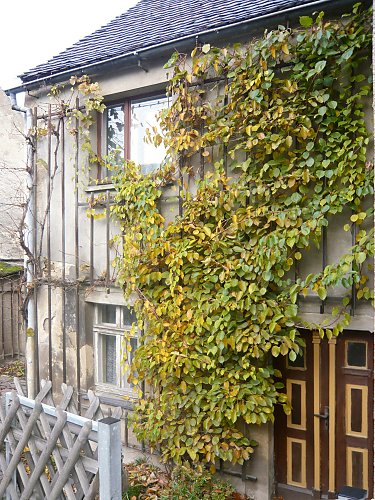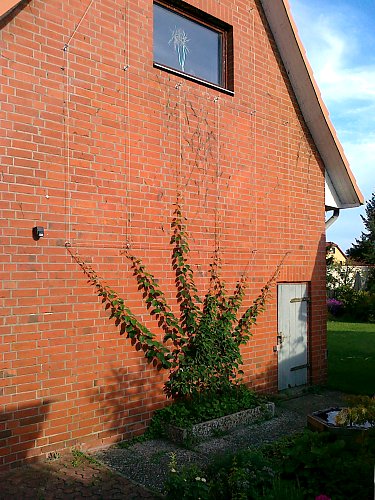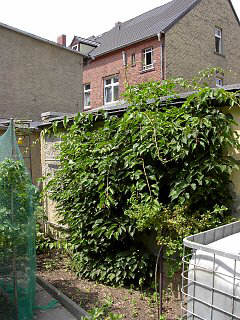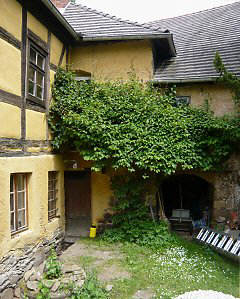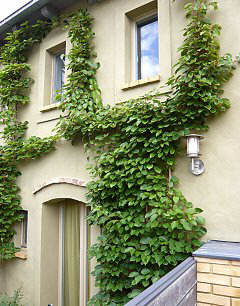Hardy ('Mini') Kiwi
Hardy kiwi is an interesting option in those places where the climate is too harsh (cold) for real kiwi. Its foliage is robust and remains from early spring to late autumn. Hardy kiwi is particularly suited for pergolas, arbours, for creating a green canopy. etc., but are sometimes also cultivated on facades and are therefore presented here as espalier fruit. Ornamental kiwi can also be an attractive alternative.
Actinidia arguta / also known as: 'arctic kiwi,' 'baby kiwi,' 'kiwi berry,' 'dessert kiwi,' 'cocktail kiwi,' 'northern kiwi,' 'grape kiwi,' 'bavarian kiwi'
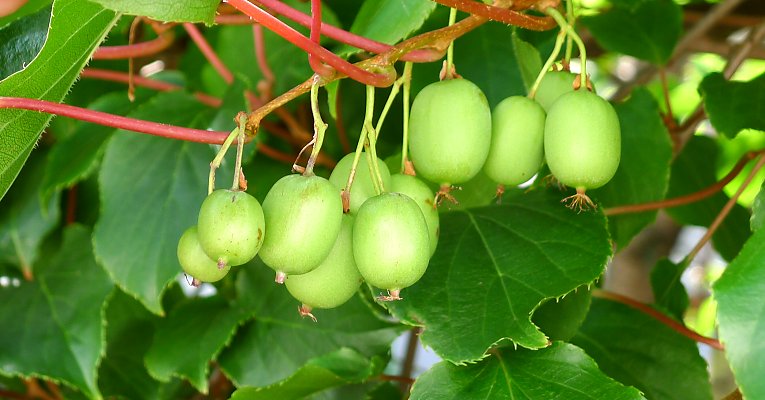
To Thrive...
In sun and protected from wind, the hardy kiwi can grow even in rough locations and at altitudes up to 600 metres. Needs cool, damp soil and regulary water, but avoid standing water.
Characteristics and Pruning
The hardy kiwi is a vine originating in Japan, China, and Korea, and was brought to Europe via New Zealand around 1050. It is undemanding and easy to care for, and you can expect a reliable yield of fruit every year. Fast growth, somewhat slower than with true kiwi, with a growth height up to about 15-20 m. Shoots are smooth, reddish-brown, hairless. Foliage lasts from April to November; leaves are very healthy. Flowering begins in late May with yellowish-white blooms that remain mostly hidden under the foliage. For optimal ripening, leave the small fruit hanging right until the first frost. The hardy, smaller version of the true kiwi is sweet like its warm-weather cousin, but does not need to be peeled; it can be popped in the mouth- skin and all- and eaten like a grape. Their vitamin C content is very high, and they are storable for post-ripening (accelerated by keeping them near apples in the refrigerator). Needs to be pruned / thinned out annually. Leaves turn yellow in autumn! Usually dioecious, so fruits only form when male and female plants stand together. The male plant may remain small on the trellis or stand next to it as a bush. The kiwi variety "Issai" is monoecious (self-fertile) but brings smaller fruit. Due to its high frost resistance, these plants will even take to potting. In leaf and habitus, hardy kiwi is remarkably similar to celastrus (bittersweet), especially to C. scandens. Celastrus, however, does not have such a pronounced club-shaped thickening of the twig under each petiole, and the leaves are not as large. *Note: If not properly pruned or shaped, structural damage similar to wisteria can occur.
Climbing Supports for the Facade
The table at the bottom of this page shows all trellis (wire rope) designs that are compatible with the hardy kiwi. Choose a trellis in our medium, or even better- heavy / massive ranges. The trunk should be trained just like a grapevine trunk would be. It's vital to guide the kiwi plant so that the main shoots and trunk won't wind around the trellis wires or lattices; the exact procedure is described in more detail in the wisteria section, as the danger of structural damage is similar. On a pergola, the individual wires should be 40 - 50 cm apart, but only every second cable will hold a branch: the other wires will hold the green shoots and leaves of the year. For facade trellises, the plant is trained as described under shaped trees. The main axes should be 35 - 40 cm apart. The kiwi shoots grow very quickly, so leave at least 1.5 metres distance between the trellis and downpipes, eaves, and lightning rods!
Wire rope trellises for mini (hardy) kiwi
Please click on the graphic illustrations for details!
| = suitable | = of limited suitability | = unsuitable |


